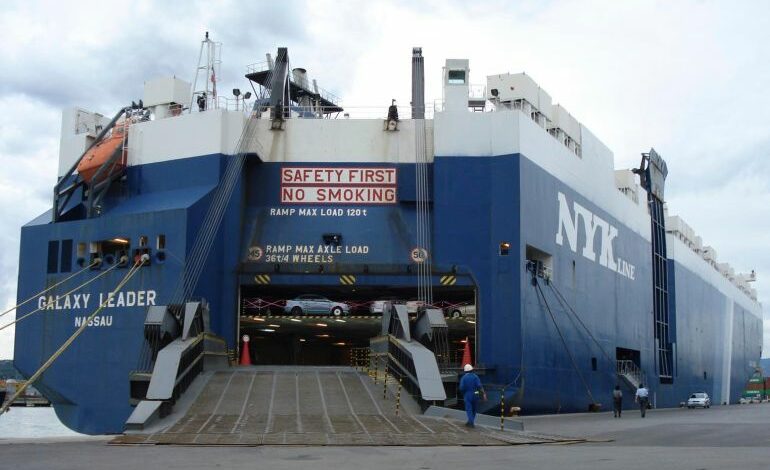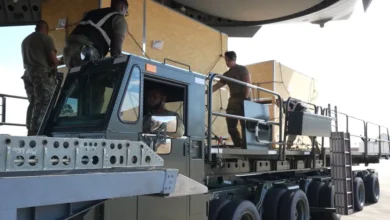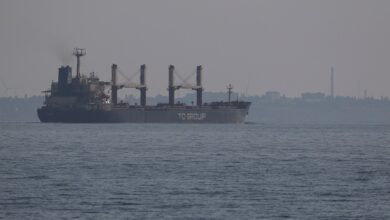Analysis: Can the US and Israel stop the Houthis from seizing more ships?

On Sunday, Houthi fighters hijacked a cargo ship in the Red Sea off the coast of Yemen.
The 189-metre-long (620ft-long) Galaxy Leader car carrier, travelling from Turkey to India, was intercepted by small fast boats and boarded by uniformed, armed personnel.
Other people rappelled from a helicopter to the deck, ordering the crew to alter course to the Yemeni port of Hodeida.
No shots were fired, and the seized ship is a civilian vessel sailing between neutral countries, but the incident still has the potential to trigger a serious escalation in the latest Israel-Palestine conflict.
In the worst-case scenario, it could be the first move in drawing the United States and Iran into direct involvement in the war.
Houthi spokesman Yahya Sare’e confirmed that the ship was seized for “being Israeli-owned” in line with his earlier announcement that the group would “not hesitate to target any Israeli vessel in the Red Sea or any place we can reach”. Israel has denied any link with the vessel although ownership details in public shipping databases suggest it is owned by one of Israel’s richest men.
Most of the Red Sea is wider than 200km (124 miles), but its southern end, the Bab al-Mandeb passage, is a chokepoint less than 20km (12 miles) wide from the Yemeni island of Mayyun across to the coast of Djibouti and Eritrea. Every year, more than 17,000 ships pass through it. That’s nearly 50 a day.
Many of them have a legal status like the Galaxy Leader, which flies the flag of the Bahamas, is operated by a Japanese company, and had a Bulgarian master and a crew from at least five other countries, none of them Israel. In the complex world of shipping, the ownership of a ship is less important than the flag of the vessel, which signifies its country of registration, and its operating company.
The Bahamas offers what is known as a “flag of convenience”. It’s a country with low taxes and less stringent labour policies, which attract operators to register their ships there. The operating company is Japan’s Nippon Yusen Kabushiki Kaisha, known as the NYK Line, which runs 818 ships.
Among almost 1,500 ships transiting the straits every month, there may be scores that could be linked to Israel and that are thus vulnerable to further Houthi hijackings.
Shipping must go on come what may, so will all “Israel-linked” ships just be left at the mercy of the Houthis?
Probably not, but the options to prevent further hijackings are limited to three: sending armed ships to accompany commercial traffic, destroying or severely limiting the Houthi offensive capacity at sea, and persuading them to refrain from attacking.
For the first option, the question is who could provide armed naval patrols in the Red Sea?
Saudi Arabia and Egypt, countries bordering the Red Sea, have strong and sophisticated navies. But Saudi Arabia is in an uneasy truce with the Houthis, which they are loathe to disturb. Egypt is trying to remain neutral and would not want to get dragged into tensions with the Houthis either. Israel cannot spare any ships for the task.
The only force left to deal with the Houthi threat would be the United States navy.
Since October 7, the US has deployed many assets to the Middle East, centred around two carrier strike groups (CSGs).The one in the Mediterranean, the CSG 12, is led by the newest and most modern nuclear-powered aircraft carrier, the USS Gerald R Ford. The CSG 2, currently in the Gulf of Oman, is fronted by the USS Dwight D Eisenhower. Each aircraft carrier is accompanied by a guided missile cruiser, two or three destroyers and a flotilla of auxiliaries, such as tankers, store ships and mobile repair bases.
Each of the two CSGs has a clearly defined task: The CSG 12 is to monitor the wider area of Israel, Palestine, Lebanon, Syria and Iraq and act against any threats that could escalate the conflict. The CSG 2 is there to watch Iran and act against it if the situation escalates.
The Eisenhower CSG is being kept outside the Strait of Hormuz as a direct message to Iran that the US has no hostile intentions, yet. Iran’s supreme leader, Ayatollah Ali Khamenei, has made it clear that his country would continue to support Hamas and the Palestinian people but it does not want to go to war itself.
Thus, the CSG 2 is demonstrating a less-than-warlike intention, staying in the Gulf of Oman, from which its aircraft could still reach targets inside Iran if the need arises or it could move into the Gulf in the unlikely case that the US should want to escalate its threat.
Outside of the CSGs, the US navy also has individual ships monitoring Houthi missile launches. On October 19, the USS Carney shot down several Houthi missiles and drones targeting Israel.
With all these assets having specific tasks, American options are limited. The only ships that can be used to escort commercial shipping are those grouped around the amphibious carrier USS Bataan, currently just south of Suez. Moving it south would weaken US potential to respond to any escalation around Gaza.
Which brings us to the second option. The Houthis are known for their readiness to take on even stronger enemies. The US targeting them directly could risk a major escalation. Washington could ask Israel to target Houthi ports with long-range missiles, but even that is risky.
So we come to the third option, de-escalation.
It seems that again Iran is the key. If the taking of the Galaxy Leader was an independent Houthi action not instigated by Tehran, the US could engage in quiet diplomacy to nudge Iran into reigning in its proxy and avoiding new hijackings at sea.
This might be the most realistic way out but only if all parties involved show restraint.
The stakes are high. Another hijacking could have a snowball effect, pulling in other countries more actively into an already devastating conflict and pushing it to the point of no return.










